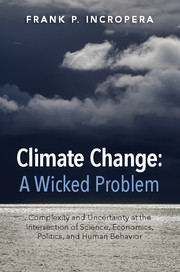 Climate Change: A Wicked Problem
Climate Change: A Wicked Problem Book contents
- Frontmatter
- Dedication
- Contents
- Foreword by Anthony F. Earley Jr.
- Foreword by G.P. “Bud” Peterson
- Foreword by Arun Majumdar
- Preface
- Acknowledgments
- Abbreviations
- 1 Energy, economics, and climate change
- 2 The Earth's climate system
- 3 Greenhouse gases
- 4 Global warming
- 5 Consequences of global warming
- 6 Mitigation, adaptation, and geoengineering
- 7 Public policy options
- 8 The politics of global warming: a history lesson and future prospects
- 9 Dissenting opinions: the great hoax
- 10 The ethics of climate change
- 11 A way forward
- Appendix A Units and conversion factors
- Appendix B Fossil fuels
- Appendix C Anthropogenic sources of natural gas and methane
- Appendix D Environmental time scales and inertia
- Appendix E Coal-fired power plants: operating conditions and costs of carbon capture and sequestration
- Notes
- References
- Index
- Plate section
Appendix E - Coal-fired power plants: operating conditions and costs of carbon capture and sequestration
Published online by Cambridge University Press: 05 October 2015
- Frontmatter
- Dedication
- Contents
- Foreword by Anthony F. Earley Jr.
- Foreword by G.P. “Bud” Peterson
- Foreword by Arun Majumdar
- Preface
- Acknowledgments
- Abbreviations
- 1 Energy, economics, and climate change
- 2 The Earth's climate system
- 3 Greenhouse gases
- 4 Global warming
- 5 Consequences of global warming
- 6 Mitigation, adaptation, and geoengineering
- 7 Public policy options
- 8 The politics of global warming: a history lesson and future prospects
- 9 Dissenting opinions: the great hoax
- 10 The ethics of climate change
- 11 A way forward
- Appendix A Units and conversion factors
- Appendix B Fossil fuels
- Appendix C Anthropogenic sources of natural gas and methane
- Appendix D Environmental time scales and inertia
- Appendix E Coal-fired power plants: operating conditions and costs of carbon capture and sequestration
- Notes
- References
- Index
- Plate section
Summary
Basic elements of a complete end-to-end CCS system include CO2 capture and compression, transport from the source to a repository, and monitoring the status of the sequestered CO2 over time. Each element contributes to the total cost of CCS. Capture and compression costs increase with decreasing concentration and pressure of CO2 in the gas stream from which it is extracted, while transport costs increase with increasing distance from the source to the storage site. Costs of monitoring the sequestered CO2 are relatively small.
The cost of carbon capture for coal-fired power plants depends on the type of power plant, its efficiency, and whether the carbon is captured by pre- or post-combustion processes. To understand these options, it's helpful to first examine the makeup of a conventional plant. Consider the system shown in Figure E.1.
Pulverized coal (PC) and air enter the boiler, where the coal is burned to produce high-temperature products of combustion (POC). As the POC pass over tubes within the boiler (the steam generator), heat is transferred to pressurized water flowing through the tubes, converting it to steam. The steam is then routed through a set of steam turbines, where work is done on the turbine blades, enabling the turbine shaft to do work on an electric generator. To reduce losses in transmission by the grid, the voltage is increased by a transformer before the electricity enters the grid. The turbine has multiple stages to accommodate reheating in the boiler and to maximize the efficiency with which work is done by the steam. After leaving the last turbine stage, the steam is converted to water in a condenser and passed through a series of feedwater heaters and pumps before returning to the boiler to repeat the process.
- Type
- Chapter
- Information
- Climate Change: A Wicked ProblemComplexity and Uncertainty at the Intersection of Science, Economics, Politics, and Human Behavior, pp. 275 - 282Publisher: Cambridge University PressPrint publication year: 2015
